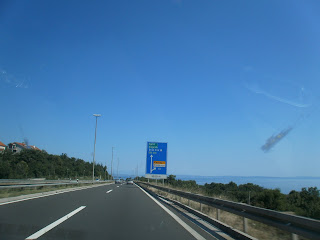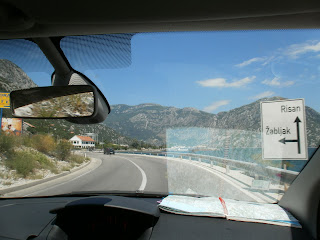A tennis buddy of mine, Gary, invited the tennis regulars to his daughter Eden's
bat mitzvah, a big coming of age thing in the Jewish faith, the only proviso being that it would be in Vancouver, BC. Only Viv and I could make it so we added some time to make it a proper trip and take in Vancouver Island too. Just as it happened I read about a website that showed deals for the day called www.livingsocial.com, I took a look at it, added Vancouver as my favourite city and forgot about it. Two days later the deal of the day was a 3-night stay at a seaside lodge/B&B on Vancouver Island. "Great" we thought and took a look at the island, the place and the lodge/B&B. All seemed pretty good and the deal was 40% off regular prices so all seemed just fine ... and that's how we found Sooke Harbour House.
 |
| Totem pole outside window - Yikes!! |
 |
| Phew, that's better. No fog now and the view from our bedroom. |
Now Vancouver Island looks pretty much like a big lump of land but in reality there's not much land that sticks together in nice big lumps, its all riven with inlets, bays, harbours, rivers and other assorted water related things. At the bottom right of the island is Victoria (its capital) and to the left along the one road in and out is Sooke (or T'Souk according to the first nation board hanging off a tree along the road).
We'd spent a few days in Toronto en route with our son, Ali, and took a direct flight to Victoria to pick up a car (with GPS this time, I remembered the occasional agony in Europe a few weeks back and didn't want to replicate that this time -- ha! Just put in Butchart Gardens and wait for fireworks. More of that later) and headed down to the B&B just in time for a nice log fire and the sound of water over St Jean de Fuca Strait -- the thread of water separating Vancouver Island, BC, Canada from Washington State, USA.
 |
| Mt Ranier in Washington State, amazing view. |
The first day we'd organised a whale watching tour which turned out to be great fun. The weather was fabulous after the morning fog had burned off and the sea glassy. The boat was called an apache and was a very fast inflatable holding 12 or so people. After 50 or so minutes with the mountain range getting no closer at all (shows that the strait wasn't so much of a thread as it appears) we passed a lighthouse at Race Rocks (see www.racerocks.com for the webcam) and after a further 5 or so minutes joined a small group of other whale watchers to check out the J-pod of killer whales that were bimbling around.

I've been on whale watching boats before and seen precisely zero, possibly due to sea sickness, but also due to not finding any. However these orcas lived here so seeing them was pretty well guaranteed but we could only stay nearby for 30 minutes by law but it was really neat seeing these marvellous huge creatures even if it was mostly the dorsal fin, tail and occasionally their backs when they came up for air.
 |
| This guy's name apparently is J22 |
 |
| Whale watching boat, the apache |
Returning we took a closer look at the seals around Race Rocks and then headed back to Sooke where Viv and I had an appointment with the world-renowned Butchart Gardens.
You would have thought that a GPS with a guide that seeks out major nearby attractions would be able to find them. You would also have thought that there would be dozens of road signs helping you find this most wonderful of attractions. I certainly would but that I suppose is me so following the single road sign into Victoria town centre was almost entirely the wrong thing to do. However all in good time we found Butchart Gardens and entered a dream world of beauty.
 |
| The Sunken Gardens. This is a disused quarry planted mainly by Mrs B herself. |
Now Vancouver Island was discovered by James Cook in 1778 on his 3rd major voyage, this time looking for the north west passage, as he ploughed ashore and was pretty much immediately killed by the locals. With him was William Bligh (of HMS Bounty fame, himself an amazing mariner which fact has been conveniently forgotten courtesy of the Hollywood movies) and a Lieutenant Vancouver. This last liked it so much (maybe because of the wonderful harbour in Victoria) he began to survey the island and before the first nation folks could do much about it, the British had landed to stay. Those early days were all about fishing and whaling and then there was gold and a massive population influx. Once that was over there remained even so a decent sized population and one thing they needed was cement to build stuff. And that's where Mr. Butchart came in.
Mr B was from Toronto where he was in the building trade. A 3rd generation Scot and doubtless a formidable Presbytarian, Mr B was a toughie. What Victoria needed was cement and the new fangled stuff called Portland Cement too, none of that wishy washy stuff. So he bought land outside the town where all the raw materials were easy to come by, only trouble being that the heat needed to make the stuff was too great for the chimneys he built. So he went to England to play golf (really, I read this in the family story!) and ran into a long lost cousin living in Kent who turned out also to be in the building trade. And he knew how to make Portland Cement. So Mr B and the other Mr B headed back to Victoria and made it work.
Mrs B from the pictures looks one formidable woman. The type of person that built an empire in fact (her name was Jennie by the way). Jennie's parents died when she was young so she was made a ward of the court. This is in the 1850's in Toronto. Somehow in a land and world not known for kindness and generosity, Jennie managed to earn an arts scholarship to study in Paris but along the way met Mr B who popped the question and took her off on honeymoon to 'this cute place called Victoria'. It all sounded good to Jennie who raised a big family (of course) and decided that what she wanted to do with her artistic talents was to take gardening to an all new level. So she began, small at first and then on an industrial scale.
 |
| These flowers are called "Dusty Miller" |
Right next door is Mr B's cement factory with all the chimneys bar one now gone. Jennie planted huge trees to mask the sight and sound of this eyesore and then started to lay out the gardens. The first formal garden was the Japanese Garden in 1908 with others coming along thick and fast when Mr B turned over more and more of the used up quarries.
 |
| Viv's peonies ... |
The family home these days is testament to her skill and devotion. The gardens are still owned and run by the family and are truly lovely. Viv went mad about the peonies and dahlias!
 |
| ... and Dahlias |
Next day we went zip lining! This is simply an adrenaline rush thing where you jump off a balcony on top of a tree in a forest and on a line hurtle towards another tree/balcony/forest combo and stop. Great fun too. I'd been in Alaska and had been the white knuckle idiot on that occasion but this time I was able to sit back and enjoy it more. So did Viv. We ran into the same family from whale watching the day before, it really is that small of a place.
 |
| Its impossible to look elegant when zip-lining |
So what does Vancouver Island do? Not sure really but logging and fishing are biggish but the main thing is tourism these days and the services that go along with it. The weather is supposedly Mediterranean and not the 7 months perma-frost found elsewhere in Canada so its a popular retirement spot too. Last month BC voted in a referendum to do away with the federal sales tax called HST and revert back to the state run sales tax. Not sure why but I guess BC is sick of supporting the eastern provinces. Interestingly too last month the government reinstated the word "Royal" in front of the air force and navy and told all their embassies worldwide to make sure the Queen's picture is placed front and centre as the head of state. I guess they must have enjoyed Will and Kate's visit here a lot.
Victoria seems a nice city -- 78,000 people supposedly. Viv and I wanted to go round the BC Museum but after zip lining and the fact it closed at 5, we wouldn't have had the time so settled for the Imax there inside which was terrific.
The B&B provided a 7-course gorging menu for us on the final night and with this and a move to Vancouver proper on the cards, today is likely to be an easy day. The ferry should be nice though.
Thanks Sooke Harbour and Vancouver Island. It was really nice. I hope to be back sometime.
























































